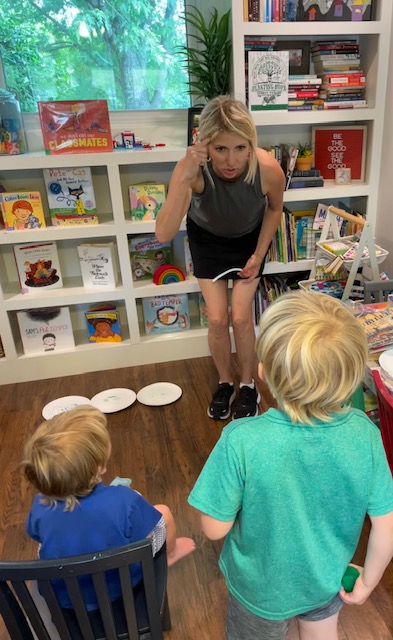This week we are sharing playful ideas on ways to teach self control strategies to your children! And, as a bonus, we (parents, grandparents, teachers and friends) are reminded of ways we can grow in this fruit of the spirit, too.

Should I Say It?
Introduce this activity by reminding kids that our memory verse this month tells us to be “Quick to listen and SLOW to speak!” But what does being slow to speak mean? (If you’re feeling super silly, use a slow voice to give your child an example of what this verse does NOT mean.) Being slow to speak means we think about things before we say them. There are lots of ideas that pop into our minds every minute of every day, but when we use self control, we don’t say everything as soon as it comes into our head! We only say things that are kind, that encourage others, and we limit what we say so that other people can have a chance to talk and be heard!
Next, I gave the boys two paper plates and asked them to draw a face on each. One face with an open mouth (representing things we say) and the other with a closed mouth (to represent things that may come into our mind, but that we should not say).
It was windy, so we moved inside to actually play the game! Everyone got a bean bag, and I began to read them sentences, one at a time, such as, “This is BORING!” The kid’s job was to then throw the bean bag onto a paper plate…either with an open mouth for things they would say or with a closed mouth for things they needed to use self control to not say.
Tip: We used painter’s tape on the back of each plate, so they wouldn’t slide around all over the floor as the boys threw the bean bags!
Example Scenarios:
- I’m faster than you.
- That’s an awesome shirt.
- Great drawing!
- Your nose is big.
- Eww! Broccoli, I’m not eating that!
- Thanks for thinking of me.
- You can’t play with us.
After statements that are better left unsaid, talk about the reason why these aren’t appropriate. In doing so, you are teaching your child a critical social skill that helps them to consider the effect their words can have on another’s feelings! As you end this activity, share the words from King David!
“Let the words of my mouth and the meditation of my heart be acceptable in your sight, O Lord, my rock and my redeemer.”
Psalm 19:14

Hot Chocolate Breathing
Many of us have heard that deep breathing can help calm big emotions, but if you’re like me, you never really bought into this idea. It seemed too simple. Nevertheless, after reading stacks of books about mindful breathing and lots of research about how twenty seconds or more of deep breathing can cause the blood flow in our brain to be redirected away from the amygdala and back to our frontal lobe where we can better process emotions, I had a lightbulb moment! The actual breathing isn’t what calms us down, it’s what the breathing does to our brains that makes us able to react to our emotions with more control…now, I can finally get behind this idea!
I’m even more of a believer after experiencing this first hand. When the boys have been in a moment of irrational emotions, I remind them about “hot chocolate breathing” from the book “Breathe Like a Bear.”

Since our boys are so young, this usually involves me doing the deep breathing exercise alongside them, and I have been amazed at the results! As I model how to take a deep breath in through our nose (like we are smelling our delicious cup of hot chocolate) and blow it out through our mouth (as we blow to cool off our hot chocolate), my own body begins to calm. I find myself speaking in a gentle tone instead of yelling. Even if the kids choose not to participate at that time, I am in a better place and regain control over my emotions before my emotions control me.
On an unseasonably chilly day earlier this month, we made hot chocolate and learned about this method for calming down. Now the boys have this skill and have been looking for opportunities to use it! The book above has many different ideas on how to teach your child deep breathing techniques! Find one that’s best for your family and be amazed at the calming effect this can have on everyone in your home.
When your child uses one of these strategies remember to point out that their heart looks more like Jesus and our Heavenly Father who is described in Psalm 145:8 as being, “gracious and merciful, slow to anger and abounding in steadfast love.”














 Mr. Marc was our next door neighbor and often played songs on his guitar as the boys ran around in the backyard. As part of the Speer Family, he grew up singing gospel music and continues using his gifts to record hymns for CB&J today! These hymns are a timeless way to remind children about the character of Jesus, and we are grateful to be able to share these with you.
Mr. Marc was our next door neighbor and often played songs on his guitar as the boys ran around in the backyard. As part of the Speer Family, he grew up singing gospel music and continues using his gifts to record hymns for CB&J today! These hymns are a timeless way to remind children about the character of Jesus, and we are grateful to be able to share these with you.